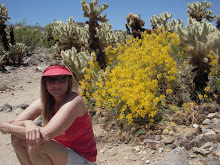







Over the Thanksgiving holiday, while visiting my in-laws in Twentynine Palms, my husband, daughter, and I spent a night at Roughley Manor, a charming bed and breakfast inn located on the east end of town near the entrance to Joshua Tree National Park.
Roughley Manor is a former homestead site founded in 1924 by Bill and Elizabeth Campbell. The original three-story house, made of native stone, is the Manor's central building with two upstairs suites, a small office, kitchen, and beautiful great room where meals are served. Lodgings include seven unique buildings, five of which are cottages.
The Campbells moved to this part of the Southern California high desert as did many World War I veterans of the time. Suffering mustard gas poisoning, Bill Campbell found a cure in the clean, dry air. While living at Campbell Ranch, the couple mined many archeological sites in the area. They teamed with the Southwest Museum of Los Angeles, logging thousands of artifacts unearthed in an area which includes the 7,500-year-old Pinto Basin located in what is now Joshua Tree National Park. At one time, the Campbells exhibited their finds in a small stone house on the property, The Museum Room, now a guest quarter. In 29 Palms,on the side of a building you'll find a mural of the Campbells, part of the city's "Oasis of Murals."
Following the Campbells, composer Allie Wrubel purchased the ranch. Wrubel wrote "Zip-a-dee-doo-dah," "The Lady from Twentynine Palms," and composed the soundtrack to "Gone with the Wind," "A Farewell to Arms," and many other films.
Since 1994, Jan and Gary Peters have been the innkeepers of Roughley Manor. Jan bakes delicious desserts served evenings in the great room, among them a banana cream pie that rates in my top 5 desserts. Breakfast was equally delicious, fat slabs of blueberry french toast with blueberry and lemon topping. Our family stayed in the newly remodeled Cholla Room, with couches, a kitchenette, and comfy beds, one of three guest rooms that were once part of a barn. The property is fronted by a line of enormous palms, and dotted with over one hundred rose bushes. A family of great horned owls live in the giant athol tree in the courtyard. They were out in the daytime, peering down at us.
Located at the edge of town, Roughley Manor overlooks Wonder Valley, the open desert east of Twentynine Palms, and the mountains bordering Joshua Tree National Park. During our visit the weather was gorgeous--70 degrees, clear, windless skies. At nighttime the Manor was quiet and serene. William and I watched the sun rise Thursday morning from our window. We went on a hike and I collected rocks for my desert garden at home. We returned to hot coffee and breakfast in the dining room prepared by Jan, served by Gary. A perfect way to start Thanksgiving... lots to be thankful for.
Photos, 2007: Roughley Manor entrance, The Museum Room, palms, the main house, original water tower, my desert shadow, collecting rocks (a hobby), breakfast in the great room






















.jpg)
.jpg)
.jpg)


